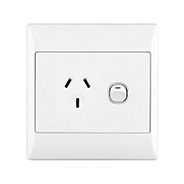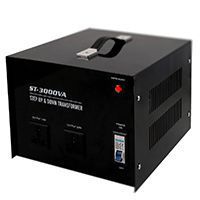How do I use my clothes iron in Fiji?
Summary
First check your clothes iron can work in Fiji:
- If your clothes iron can run using 240 volts or can support dual voltage (how to check) then you will only need to bring the correct power adapter for Fiji listed on this page if the plug on your clothes iron won't fit in the outlet.
If not then either:
- Use a dual voltage travel iron [2] - you may still need to use the right power adapter for Fiji however these cheap lightweight accessories are designed specifically for the rigors of travel.
- Use a power converter (or voltage transformer) - you can then use your existing clothes iron and other applicances with a 240 volt Fijian power outlet, however this is significantly bulkier, heavier and more expensive than a dedicated travel clothes iron. A power converter changes the voltage but not the actual shape of the plug on your clothes iron to fit in the types of power outlet used in Fiji, so check that your power converter comes with a suitable power adapter for Fiji otherwise you will need to purchase another power adapter. Please be aware that your domestic clothes iron might not be suited for travelling and you risk potential damage in your luggage. [5] [AD]
Using a clothes iron in Fiji
Will my clothes iron work in Fiji?
This depends on if your clothes iron can handle the 240 volt power outlets used in Fiji. If you're using either a dual voltage clothes iron or your clothes iron can handle 240 volts and you have the correct power adapter then you can use it in Fiji. If not then you will need to consider purchasing either a dual voltage travel iron [2] or a heavier and more expensive power converter. Read the section on do you need a voltage converter to use your clothes iron for help deciding which solution is more suitable. [5] [AD]
Can I use my US clothes iron in Fiji?
The instructions on this page assume that you are a reader from the US travelling to Fiji and provide guidance for using your American clothes iron with a Fijian power outlet.
Fiji power outlets and plug sockets
What is the electrical frequency used with a Fijian power outlet?
The frequency of the alternating current from a Fijian power outlet is 50 Hz. [6]
What mains voltage is used in Fiji?
Power outlets in Fiji are 240 volts.

Type I power outlet
Which power adapter will you need when using a clothes iron in Fiji?
The type of power outlet used in Fiji is type I. You can recognise this plug outlet by the 3 thin slots for the live, neutral and earth. A Type I power adapter is suitable for powering a 240 volt clothes iron in Fiji; read the simple instructions below for full details of using a clothes iron in Fiji. Note that unless you that have a dual voltage clothes iron you will need to confirm if you also need to bring a power converter. [4] [7] [AD]
Dual voltage travel irons
How can you tell if your clothes iron is dual voltage?
One method to tell if your clothes iron can accept dual voltage is to look for either a sticker or numbers printed on the handle, base or the plug of the clothes iron. The location might vary depending on the make and model of your clothes iron and should also be written in the instruction manual or on the box. Some dual voltage clothes irons might change automatically but other models will have a button or switch which allows you to change between different voltage ranges.
- Single voltage might say a specific number - such as 110V. If this number matches the 240 volts used in Fiji then you should be able to use your clothes iron with a Fijian power outlet.
- Single voltage could also have a small voltage range with a dash to accomodate small voltage fluctuations - such as 100-120V. If the 240 volts used in a Fijian power outlet falls within the range shown on your clothes iron then you can use it in Fiji.
- Dual voltage will typically say a large range separated with a slash - such as 100/240V. Your clothes iron will be capable of being used in Fiji or any other country if these numbers are shown.
Travelling to Fiji with a clothes iron
Can you carry on a clothes iron to Fiji?
According to the TSA guidelines for clothes irons there are no restrictions when bringing a mains powered clothes iron in your carry on luggage through airport security in the US. The TSA also recommends that you should check that the airline which is flying you to Fiji will allow clothes irons onboard and that it will fit in the overhead bin or underneath the seat of the aircraft. The TSA also suggests wrapping cables tightly around electronic items. If you do intend to pack a fragile or expensive clothes iron in your hand held luggage then it is advisable to bring hard carry on luggage as this offers the greatest protection against drops and knocks during transit. [8] [9] [AD]
Power converters for Fiji
Do you need a power converter in Fiji to use your clothes iron?
A voltage transformer (or power converter) allows a clothes iron using a different voltage to operate using a 240 volt power outlet used in Fiji. Travellers wishing to bring their own clothes iron can use a power converter, but it can be more costly to purchase a power converter than it is to buy a dedicated dual voltage travel iron [2]. Also, a travel clothes iron can be substantially smaller than a power converter making a travel clothes iron more suited for travelling. [5] [AD]

Voltage converter
What is the difference between a voltage converter and a power adapter for Fiji?
A small, cheap and lightweight power adapter (or plug adapter) changes the shape of the plug on your clothes iron to fit into a power outlet in Fiji, but a heavy and bulkier power converter converts the voltage of 240 volts from a Fijian power outlet to work with a non-240 volt clothes iron. [5] [AD]
How to use a clothes iron in Fiji using a type I power adapter
A page showing how to power your clothes iron in Fiji with a Type I travel charger.
- Check that the iron is either a dual voltage travel iron [2] or can work with a 240 volt power supply; if not then do not proceed as you might blow a fuse, damage your iron or create an electrical fire hazard. Travel irons sometimes have a switch to toggle between voltages, before operating the iron ensure you have set it to the 240 volt setting; please refer to the manufacturers instructions for more information on where this switch is.
- You'll need to bring a Type I power adapter [4] if the shape of plug on your clothes iron isn't the same type of plug outlet which is used in Fiji. The power adapter is designed to convert different plugs on appliances from other countries into a power outlet found in Fiji by changing the shape of the plug, however it doesn't change the voltage of the clothes iron to work with a 240 volt outlet.
- Start by taking the Type I power adapter and plugging it in the Fijian power outlet. This power supply (technically called the Type I power outlet [3]) can be recognised by the 3 thin slots for the live, neutral and earth.
- Plug in the clothes iron into the Type I power adapter.
- Switch on the Fijian power outlet.
- The iron can now be turned on. [AD]
See also
External links
We endeavour to ensure that links on this page are periodically checked and correct for suitability. This website may receive commissions for purchases made through links on this page. As an Amazon Associate WikiConnections earn from qualifying purchases. For more details please read the disclaimers page.
- Wikipedia - Fiji Wiki page
- Amazon - dual voltage travel iron
- iec.ch - Type I power outlet
- Type I power adapter - A Type I electrical adapter, compliant with AS/NZS 3112, fits in a standard Australia electrical outlet. This adapter features two flat pins in an inverted V-shape with an earthing pin and is also commonly used in New Zealand, China, and Argentina..
- Power converter - Heavy-duty power converters are designed to convert voltage levels between different electrical standards, shifting between 110V/120V and 220V/240V with both 50Hz and 60Hz, often incorporating safety features such as fuse protection and circuit breakers..
- Wikipedia - WikiPedia - Mains electricity by country -
- iec.ch - IEC World Plugs by location -
- tsa.gov - TSA guidelines for clothes irons -
- Hard carry on luggage - Hard carry-on luggage features a tough outer shell to absorb impact and is recommended for transporting heat tools or fragile electronics in overhead bins..
| 2 other devices in this category | |
| Connecting a Fijian power outlet to: |
|